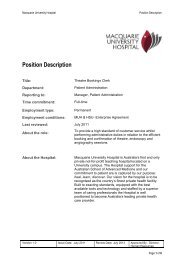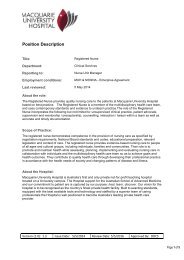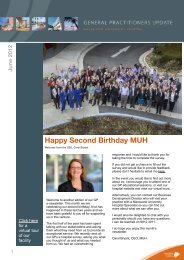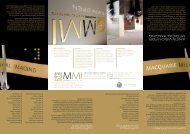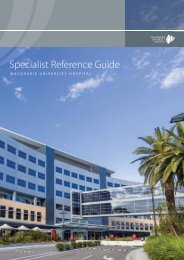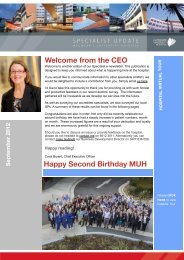Plenary Oral Presentations - Macquarie University Hospital
Plenary Oral Presentations - Macquarie University Hospital
Plenary Oral Presentations - Macquarie University Hospital
You also want an ePaper? Increase the reach of your titles
YUMPU automatically turns print PDFs into web optimized ePapers that Google loves.
16 th International Meeting of the Leksell Gamma Knife ® SocietyMarch 2012, Sydney, AustraliaVA-171Radiosurgery for symptomatic cavernous malformationsLong-term results of our institute and all over Japan1Yoshihisa Kida, 1 Toshinori Hasegawa, 1 Takenori Katoh1Komaki City <strong>Hospital</strong>2Scientific Committee of Japanese Leksell Gamma Knife SocietyObjective: Long-term results of radiosurgery to cavernous malformations(CMs) are reported, andcompared with the symptomatic cases treated with surgery or followed up conservatively.Methods: There are 152 cases of symptomatic CMs, either by hemorrhage, neurological deficits or byepilepsy, which were treated with gamma knife(A). There are another 13 cases with surgical resection(B), and 33 cases with conservative treatment(C) as symptomatic controls.Results: Majority of lesions in Group (A) are located in eloquent areas like brainstem or basal ganglia,followed by lobar and cerebellar lesions. With the mean maximum and marginal dose of 26.4 and14.9 Gy respectively, 30% of them showed a shrinkage and the others were unchanged in the meanfollow-up of 55.4 months. Hemorrhage rate after radiosurgery are far decreased to 3.2%/year/case,which is almost one tenth of the one during 5 years before gamma knife (31.8%). Hemorrhage rateshowed 8% in the first year, then apparently decreased to less than 5% subsequently and finallyreached near to 0% in the 7th year. Convulsive seizures associated with CM either disappeared ordecreased in almost 70% of patients, who were treated with gamma knife.In cases of surgical resection, they had a similar hemorrhage rate to Group (A). In contrast, thehemorrhage rate in Group (C) was 7.6 %/year/case during 62 months of mean follow-up, which ismore than double than Group A.Conclusions: The purposes of radiosurgery for symptomatic CMs are not totally irradicate the lesions,but to successfully control the symptomatic events. Because of markedly decreased rate of hemorrhagewith acceptable rate of complications, radiosurgery for cavernous malformation is warranted andadvisable, especially for CMs in brainstem and basal ganglia with less than 15Gy at the margins.However, suprotentorial CMs associated with intractable seizures can be treated with surgery, sincethe effects of radiosurgery are not consitent. Moreover, a higher marginal dose more than 18Gy,which may cause adverse effects more often, is required to successfully control seizures.In this report, the results of radiosurgery from many institutes in Japan are collected and comparedwith ours.78



